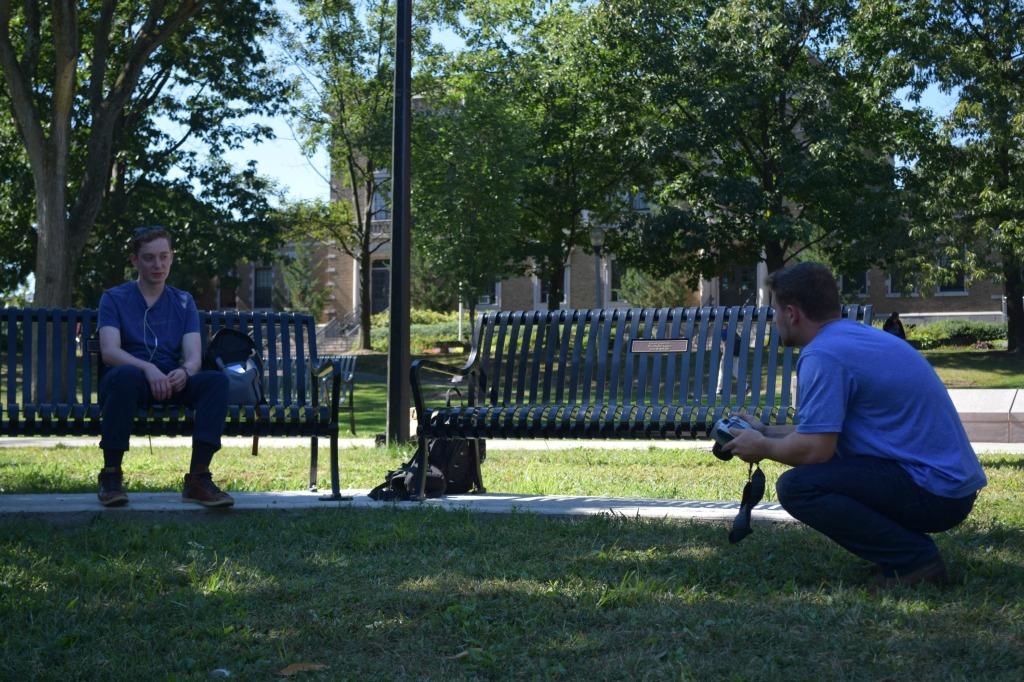Meet the man behind Humans of UMass
October 7, 2015
Nick Vigneau rounds the path between the Student Union and the campus pond, eagerly searching for someone to talk to.
“That guy under the tree,” he says, pointing, “maybe I’ll talk to him.”
Vigneau keeps walking, pausing no more than a second before spotting a boy sitting on a bench that overlooks the pond. He approaches the stranger with a confident caution, as if he were a lion tamer greeting a feline.
According to Vigneau, introductions are crucial when starting a conversation.
“Be friendly and smile, because your energy will set the tone. Once you tell someone your name and they tell you theirs, you have gotten past a certain point,” he explains.
Vigneau is the founder and one-man operator of the Humans of UMass Instagram page. After spending three years at UMass, he started the page in February 2015, and since then has reeled in just over 5,100 followers.
The senior political science and legal studies major created the account because he felt that the stereotype of “ZooMass” didn’t accurately depict all that the University of Massachusetts Amherst has to offer. Drawing from the Humans of New York Instagram account, known for its inspiring photo collections and quotes from people around the city, Vigneau created his own page and set out to change perspectives.
“It shows you things that you would never see looking at a person,” says Vigneau. “When you look at somebody, you make a judgment very quickly. In reality, who they are and what is on the inside are very different, and that kind of struck me. I wanted to bring that to the school,” he explains.

Vigneau begins setting up his camera as he sits on a bench across from the boy. It’s not long before the two are talking, as Vigneau launches right into an interview. The benches suddenly become a set, and the boy transforms into Vigneau’s latest subject, as he moves about collecting candid photos in a fluid motion that can only come from a great deal of experience.
Each post tells the story of those featured through a picture and a quote. Both have to be independently intriguing, yet use a similar emotional tone. In order to do so, Vigneau takes 30 to 40 photos per interview and looks at them while listening to the interview.
The picture is the face of the story; it is comprised of a background, scene, props, and minor details. Vigneau admits that becoming acute to all of these components was a skill he learned over the course of the job.
Vigneau looks to detect and arouse any contradiction or irony between the picture and quote by bringing attention to an aspect that may have been overlooked. He will never change what was said, but will often manipulate the order to better display any ironic or contradictory angles. Despite the gritty effort that is put into finding the right quote, the picture is what inspires Vigneau to pursue a story.
The photos, he explains, are never posed and commonly include eye contact. The goal is to make the person who is looking at the photo feel like they are having a conversation with this stranger.
“People get most uncomfortable when I start taking pictures of them while they talk but if I don’t act like it is weird, they eventually don’t either,” Vigneau explains.
According to Vigneau, about every seven out of 10 people he approaches on campus are willing to talk to him and agree to a feature on the page. He typically finds people within the vicinity of central campus and prefers that they are alone because, he says, people tend to trim what they say to suit their friends.
“You’d be surprised what people tell [me] because there is no judgment attached,” he says.
From there, an interview can take anywhere from 30 seconds to over an hour, depending on where the conversation goes. Vigneau values an organic interaction and regards it as “a casual conversation.” He describes himself as an “active listener with a couple of prompting questions.”
Vigneau explains that throughout each interview he has to maintain emotional control over the conversation, meaning he must filter his reactions to sensitive material in a way that simultaneously acknowledges that his subject has been heard and encourages them to keep sharing.
“All people just want to be listened to,” says Vigneau.
Email Erica Garnett at [email protected], follow her or on Twitter @GarnettErica.
